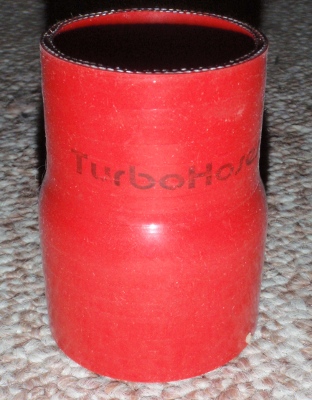DN Intake Hardpipes and Hose Reducers
One of the first additions I made to my Stealth was a set of DN Performance Intake Hardpipes - the stainless steel pipes that fit in-between the intake splitter bubble (just downstream of the MAF) and the turbo compressor inlet. One of the stock hoses had a tear in it, and rather than replace it with another soft hose, I went for steel.
These are nice pieces of metal work; the OEM hoses are a complex, compound shape and it takes no small degree of skill to build a pipe that will fit into the same space as the rubber one, especially as the rubber hose has a good deal of intrinsic flex to it, so it will deal with misalignment far easier than a non-flexible steel part will. Getting those pipes on was a little bit of a bear.
That's normal and acceptable. Frequently there are tradeoffs involved with aftermarket parts, and a common one is trading "ease of installation" for "performance", "appearance", or "durability".
But DN compounds the problem by taking the same shortcut that many aftermarket suppliers fall for - the difference between "easy" and "right".
In this case, I'm talking about the connection between the pipe and the turbo inlet.
Commonly available tubing, as suitable for constructing intake pipes, comes in fractional inch sizes, usually on the quarter-inch step. This means that you can get tubing in 2.0" OD, 1.75" OD, and 1.5" OD etc. Tubing cannot be ordered in specific diameters outside of this selection without paying a horrific price premium, because none of the tubing mills have the tooling to make tubes to size. Trying to get custom tubing means somebody upstream having dies made specifically for your job, and those costs will be passed down to you.
Given the small and notoriously price-sensitive nature of the performance aftermarket, you're not making a whole lot of money on each part anyway, so there's no room to go down the custom tube diameter road without jacking the price to the point where the part won't sell.
Plus, your market equates "bigger" with "better" and so there are marketing reasons to keep things a little oversize. And maybe your customer has an aftermarket turbo with a larger inlet, so now that part fits him too. There are all kinds of good reasons why the end of the pipe is 2.0" in diameter where the OD of the turbo inlet snout on a 9B or 13G (at least) is 1.81".
So far, no foul. That diameter mismatch is what it is.
DN's mistake - and as I said earlier, they are FAR from being the only suppliers that do this - is to provide as a coupler a length of 2" ID silicone hose. Works fine on the pipe end, but it must be crushed down 0.2" (that's nearly a quarter inch) in order to grip the turbo inlet snout.
It can be done, but it is beyond aggravating. A 2.0" silicone hose just does not want to be squeezed that way. It takes a lot of torque on the hose clamp to make it happen, and hose clamps don't like to be torqued that hard, so the clamp fights as much as the hose does. It makes an already difficult installation that much more annoying, and it takes a lot of work to get the seal right. I have caught that hose leaking at the seal many, many times.
That's not the hose's fault; it is designed to fit over a 2.0" OD bung. The fault lies with the supplier who provided a section of 2.0" ID straight hose and instructions to just "crank down on the clamp until it seals".
I call bullshit. That may be "easy" for the supplier, but it isn't right.
THIS is "right":

This is a 2.0" ID to 1.75" ID reducer hose from Turbohoses.com. It fits perfectly over both the end of the hard pipe and the inlet snout of the turbo. No fuss, no muss, no "crank 'er down 'till she fits".
Problem solved.
If you buy an aftermarket part, don't let them get lazy on you. Make them provide the right parts. And the other side of that coin is don't freak out on price (the reducer hose is more expensive than the straight hose, and it is fair for the supplier to pass along that cost!) when the supplier is forced to cover his costs on making the part right in the first place.
